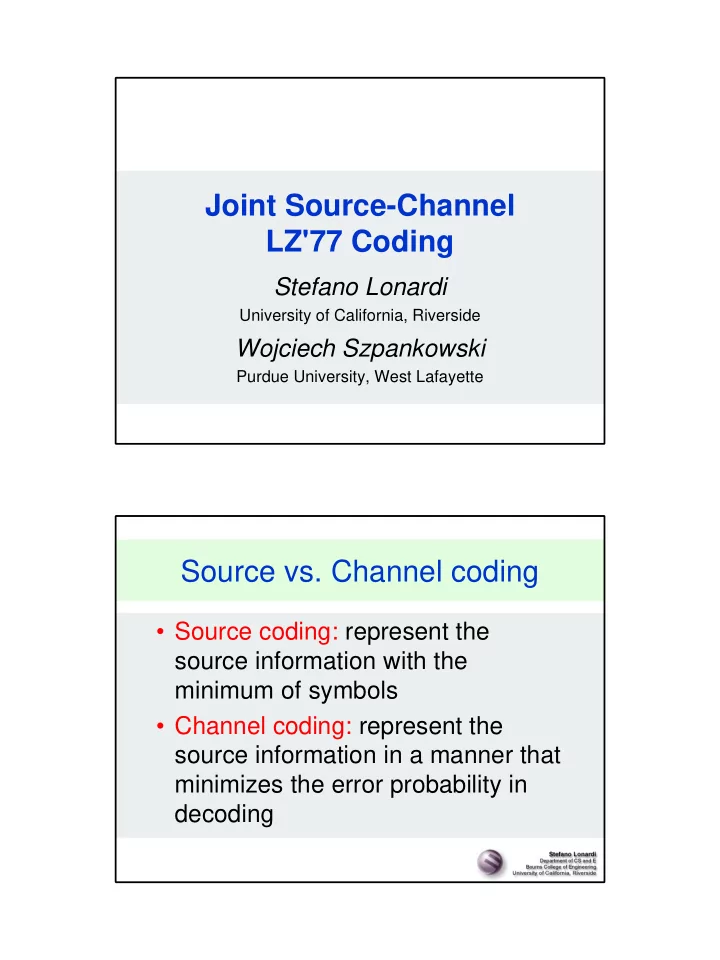

Joint Source-Channel LZ'77 Coding Stefano Lonardi University of California, Riverside Wojciech Szpankowski Purdue University, West Lafayette Source vs. Channel coding • Source coding: represent the source information with the minimum of symbols • Channel coding: represent the source information in a manner that minimizes the error probability in decoding
Problem definition • How to achieve joint source and channel coding in LZ’77 (by adding error resiliency) –without significantly degrading the compression performance, –and keeping backward compatibility with the original LZ’77? Encoding “Dear Bob, “Dear Bob, How are you LZRS’77 T.gz How are you LZRS’77 T.gz doing today? …” doing today? …”
Decoding (no errors) “Dear Bob, “Dear Bob, T.gz LZ’77 How are you LZ’77 T.gz How are you doing today? ...” doing today? ...” “Dear Bob, “Dear Bob, LZRS’77 T.gz LZRS’77 How are you T.gz How are you doing today? …” doing today? …” Decoding (with errors) ? Corrupted T.gz LZ’77 Corrupted T.gz LZ’77 “Dear Bob, “Dear Bob, LZRS’77 Corrupted T.gz Corrupted T.gz LZRS’77 How are you How are you doing today? …” doing today? …”
Roadmap • We will show how to obtain extra redundant bits from LZ’77 • We will show how to achieve error resiliency in LZ’77 LZ’77: which of these pointers do we choose? history current position
By choosing one of these pointers we are recovering two extra redundant bits. Note that we are not changing LZ’77 history current position 00 01 10 11 Extra bits recovering • Definition: a LZ’77 phrase has multiplicity q if has exactly q matches in the history • Given a phrase with multiplicity q , we log q can recover bits 2
Average case analysis • Theorem: Let Q n be the random variable associated with the multiplicity q of a phrase in a string of length n . For a Markov source E[Q n ]=O(1) as n? 8 Average phrase multiplicity average phrase multiplicity (news) average phrase multiplicity (paper2) 7 9 8 6 average phrase multiplicity average phrase multiplicity 7 5 6 4 5 4 3 3 2 2 1 1 0 0 0 50000 100000 150000 200000 0 10000 20000 30000 40000 50000 60000 70000 position in the text position in the text
Recent results • Theorem: For memoryless sources [ ] 1 = + E Q small fluctuations n H − + − k k [ ] p (1 p ) (1 p p ) = = P Q k n kH where H is the entropy of the source, and p is the probability of generating a “0” Number of bits recovered mito paper2 6000 16000 14000 5000 12000 4000 bits extracted bits extracted 10000 3000 8000 6000 2000 4000 1000 2000 0 0 0 10000 20000 30000 40000 50000 60000 70000 80000 90000 0 10000 20000 30000 40000 50000 60000 70000 80000 90000 position position progc news 10000 45000 9000 40000 8000 35000 7000 30000 bits extracted bits extracted 6000 25000 5000 20000 4000 15000 3000 10000 2000 1000 5000 0 0 0 5000 10000 15000 20000 25000 30000 35000 40000 45000 0 50000 100000 150000 200000 position position Remark Remark: more bits can be recovered by relaxing the greediness : more bits can be recovered by relaxing the greediness
Reed Solomon codes • RS codes are block-based error correcting codes (BCH family) • RS(a,b) code – a=2 s -1 , where s is the datum size – has (a-b) “parity” bits – can correct up to (a-b)/2 errors • We used RS(255,255-2e), which can correct up to e errors LZRS’77 encoder (off-line) • compress the file with LZ’77 • break the compressed file in blocks B 1 ,…, B m of size 255-2e • for i ← m downto 2 – encode with RS(255,255-2e) block B i – embed the extra 2e parity bits in the pointers of block B i-1 • encode with RS(255,255-2e) block B 1 • store the extra parity bits at the beginning of the file
LZRS’77 encoding optional LZRS’77 decoder (on-line) • (assume RS i are the 2e parity bits for B i ) • decode and correct block B 1 +RS 1 • decompress block B 1 and recover RS 2 • for i ← 2 to m – decode and correct block B i +RS i – decompress block B i and recover RS i+1
Experiments: gzip • gzip issues pointers in a sliding window of 32Kbytes (typically) • The length of phrases is represented by 8 bits (3-258) • Strings smaller than 3 symbols are encoded as literals gzip • gzip always chooses the most “recent” occurrence of the longest prefix “…the hash chains are searched starting from the most recent strings, to favor small distances and thus take advantage of the Huffman coding…” 10
“Hacking” gzip • We modified gzip-1.2.4 to evaluate the potential degradation of compression performance due to changing the rule of choosing always the most “recent” occurrence • As a preliminary experiment, we simply chose one pointer at random gzip vs. gzipS 11
Error correction (simulation) • We chose e=1, e=2 and b=10, b=100 • For b blocks, we injected 1,…,b uniformly distributed errors • We measured the number of times that the file was decoded correctly (out of a few hundreds simulations) Error-correction probability of the file incorrectly decoded (e=2, b=100) 1.2 1 0.8 probability 0.6 0.4 0.2 0 1 4 7 10 13 16 19 22 25 28 31 34 37 40 43 46 49 52 55 58 61 64 67 70 73 76 79 number of injected errors 12
Findings • Method to recover extra redundant bits from LZ’77 • Extra bits allow to incorporate error resiliency in LZ’77 – backward-compatible (deployment without disrupting service) – compression degradation due to the extra bits is almost negligible 13
Recommend
More recommend